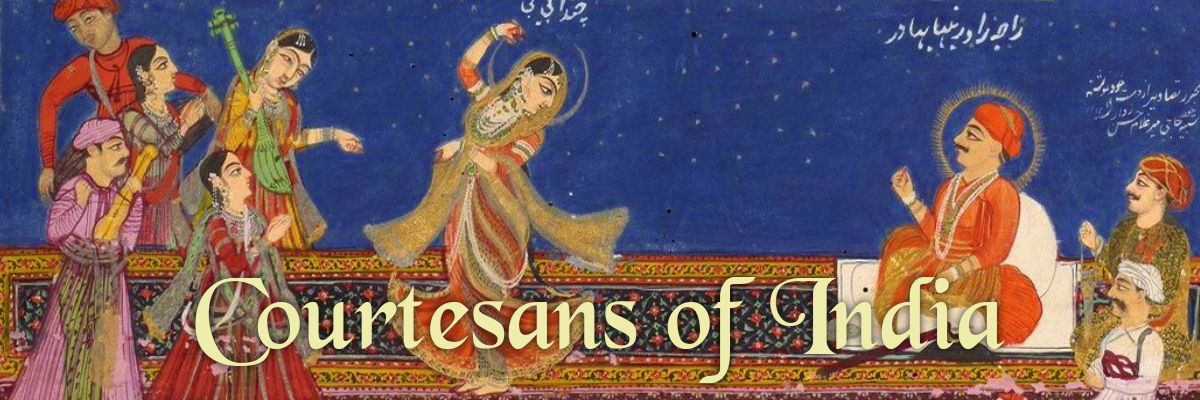One of the most famous courtesan stories to come out of India, Umrao Jaan follows the many heartbreaks and tragedies of a young girl named Amiran, who, after being kidnapped and sold to a brothel, rises to becoming the famous Lucknow courtesan, Umrao Jaan. Some of the film’s songs are now considered classics of Bollywood cinema and its popularity helped to spawn a 2006 remake.
The Umrao Jaan film is based on the Umrao Jaan Ada novel. In the novel’s introduction, the author claims, perhaps for artistic effect, that the story is a real memoir relayed to him by a real person.
Questions to Consider
- What does Umrao’s talent for writing poetry indicate about the film’s “idea” of courtesans? Are all courtesans hidden, unappreciated talents, or is Umrao exceptional?
- Can a courtesan be “forgiven” from the film’s perspective? Can a courtesan “deserve” a husband? Does the film subscribe to the views of courtesans as “dirty and fallen” women, or does it challenge them?
- Which of Umrao Jaan’s qualities could suggest she “deserves” forgiveness and/or companionship? Do other courtesans “deserve” these things? Do less talented courtesans? Do willing courtesans?
- What dimensions of sympathy does the film create for Umrao? Is the sympathy respectful? Paternalistic? Who do we lack sympathy for? Why?
- Does the film imply tragedy is in store for all courtesans, or just Umrao? How culpable are courtesans in their fate, according to this film?
Tawaifs and Kidnapping
We encourage our readers to think carefully about Umrao Jaan’s kidnapping. What happens to the public understanding of a marginalized group when arguably the most influential story about that group images their community leaders as cruel kidnappers? What effects could this understanding have on real-world people? If many tawaifs intentionally joined kothas to escape terrible circumstances—a situation described in the quotes below—what could happen to their refuge when the well-meaning public mistakes those individuals’ refuge from despair as always and only a source of despair? Is sympathy always helpful? Is “saving” always heroic?
Consider the following quotes from “Lifestyle As Resistance: The Case of the Courtesans of Lucknow, India” by Veena Oldenberg:
It is popularly believed that the chaudharayan [chief courtesan]’s most common mode of recruitment has always been kidnapping; that the tawa’if were linked to a large underground network of male criminals who abducted very young girls from villages and small towns and sold them to the kothas or nishatkhanas (literally, pleasure houses). This belief was fueled, if not actually generated, by Lucknow’s famous poet and litterateur, Mirza Hadi Ruswa, in his Umrao Jan Ada. The novel first appeared in 1905, was an immediate success, and was translated into English in 1961. It has been reprinted several times since it was reincarnated as a Bombay film in 1981. The influence this novel has exerted on the popular imagination is enormous; it is the single most important source of information on courtesans of Lucknow, and by extension, the entire profession as it was practiced in the nineteenth century, in Northern India.
(264)
One of the older courtesans I interviewed, who had known Ruswa personally, gave the book a mixed review. She commended Ruswa for understanding the mentality of the courtesan but blamed him for inventing characters such as the “evil kidnapper” and the exploitative madame who became the stuff of later stereotypes.
(265)
Kidnapping may have been (and perhaps still is) one of the methods by which girls find their way into the tawa’if households, but it is certainly not the most common. From my interviews with the thirty women, who today live in the Chowk area of Lucknow, and whose ages ranged from thirty-five to seventy-eight, a very different picture emerged. In recording the life stories of these women, who spanned three generations, I found that the compelling circumstance that brought the majority of them to the various tawa’if households in Lucknow was the misery they endured in either their natal or their conjugal homes….
Not one claimed that kidnapping had been her experience, although they had heard of such cases….
The problem, according to Saira Jan, a
(266)
plump woman in her early forties, who recounted her escape from
a violent, alcoholic husband at length and with humor, was that
there were no obliging kidnappers in her mohalla (neighborhood).
“Had there been such farishte [angels] in Hasanganj I would not
have had to plot and plan my own escape at great peril to my life
and my friends, who helped me.”‘
